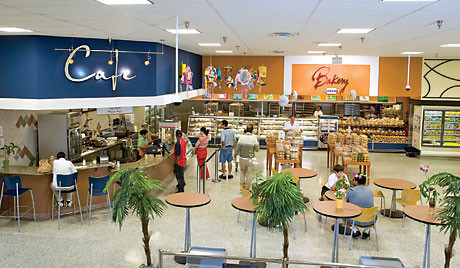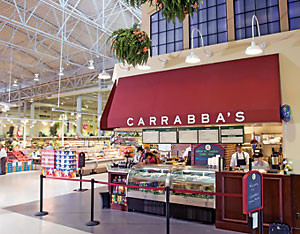SHARE:
Retail
The Art of the Aisle
A walk through Florida's grocery stores shows how the chains use design to sell to consumers who are demanding more of everything.
The ‘Racetrack’
Insiders call the perimeter area of a grocery store the “racetrack.” Most shoppers dart in and out of aisles rather than methodically moving up and down aisles as they shop. That behavior, which Paco Underhill, founder and CEO of Envirosell Inc., calls the “boomerang” effect, makes the perimeter area — including the wide aisles at the front and rear of the store, the displays at the end of the aisles and key departments on the rim of the store — a crucial selling point. Sorensen’s research shows that consumers who follow the racetrack as they shop spend more than shoppers who chart their own courses.
Deli-Produce-Bakery
Most chains now use some combination of produce-deli-bakery to try to engage consumers with sights and smells as they enter. Regardless which “sensory” department is closest to the front of the store, the design focuses on slowing a customer’s progress into the store, encouraging more stopping, looking and buying. Long, wide aisles are few. Bakery sections, for example, usually feature an array of carts and tables. The bakery is particularly prominent in the design of Publix’s Sabor markets, which target Hispanics. The bakery in the Publix Sabor store in Hialeah, for example, is 2,700 square feet, offering more than 100 fresh pastries daily. Sabor’s bakery accounts for 3.8% of store sales — twice the industry average of 2% — according to the trade publication Progressive Grocer.
 THE GOODS: The bakery at Publix’s Sabor market, which targets Hispanics, is 2,700 square feet and offers more than 100 fresh pastries daily. Sabor bakery sales are twice the industry average. [Photo courtesyPublix] |
Bakeries are also popular for cross-merchandizing — using special displays to pair items from separate departments. Winn-Dixie, for instance, pairs its cakes with party bags and dessert wines.
Meanwhile, produce sections of many grocery stores have gotten larger in recent years as demand for both more produce and more kinds of produce have grown. The U.S. Department of Agriculture charted a 12% increase per capita in consumption of fresh fruits and vegetables between 1987 and 1997.
Many chains highlight offerings of locally grown or organic produce or offer racks of recipe cards to prompt a customer’s interest in a particular fruit or vegetable. Sweetbay’s produce section features low tables and wheeled carts that customers can see over and around and that encourage people to move in a circular, rather than linear, fashion. Red peppers and other colorful vegetables are purposefully interspersed with heads of lettuce to provide a palette of color to entice the shopper: “A long run of green product becomes overwhelming,” explains Steve Smith, Sweetbay’s vice president of merchandizing. The deli department — usually located in the right front or left front of the store — also is getting bigger. The size of the average service deli has risen from 1,390 square feet in 1998 to around 1,610 square feet in 2005, according to Progressive Grocer. Aside from sliced-to-order meats and cheeses, that space is used to offer a wider array of prepared “to-go” foods than the now-familiar rotisserie chicken. According to the International Dairy Deli Bakery Association, “today’s deli selling environment is not about selling individual products, but selling the ‘eating occasion’ ” to the consumer.
|
More than 60% of consumers eat meals that were not prepared at home at least once a month, according to the Arlington, Va.-based Food Marketing Institute. Eighteen percent do it once or twice a week, and 4% three or more times a week.
Publix is blurring the line between traditional grocery store and restaurant even further, opening a 1,000-sq.-ft. Carrabba’s Italian Market at the University Walk Publix in Sarasota. The market features a wood-burning pizza oven and wood-fired grill and offers on-the-go soups, pizza and panini sandwiches. The grocer is also testing an expanded deli concept with sit-down and take-out meals at a store in Lake Mary.





















 Business Beat - Week of May 3rd
Business Beat - Week of May 3rd


